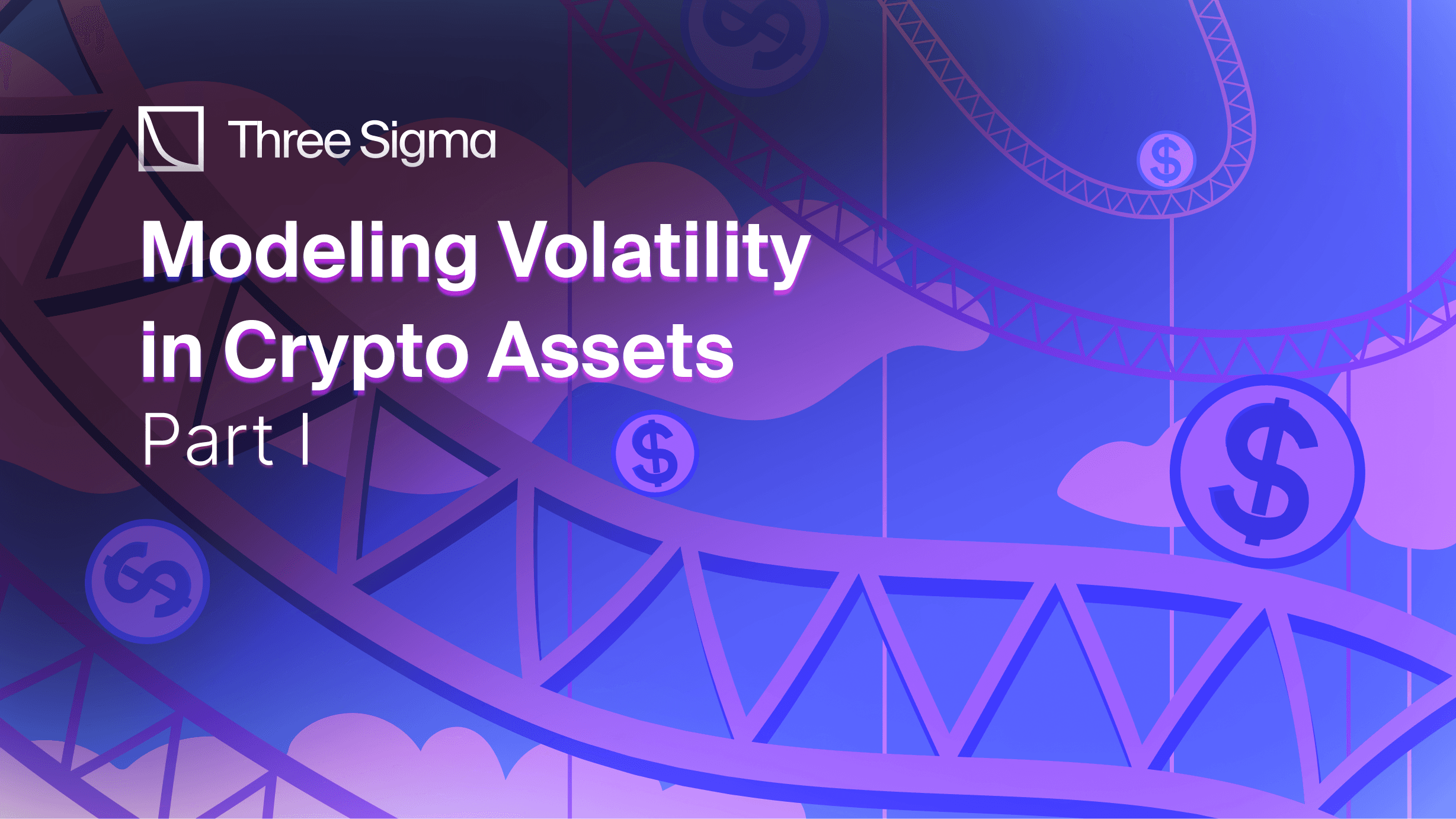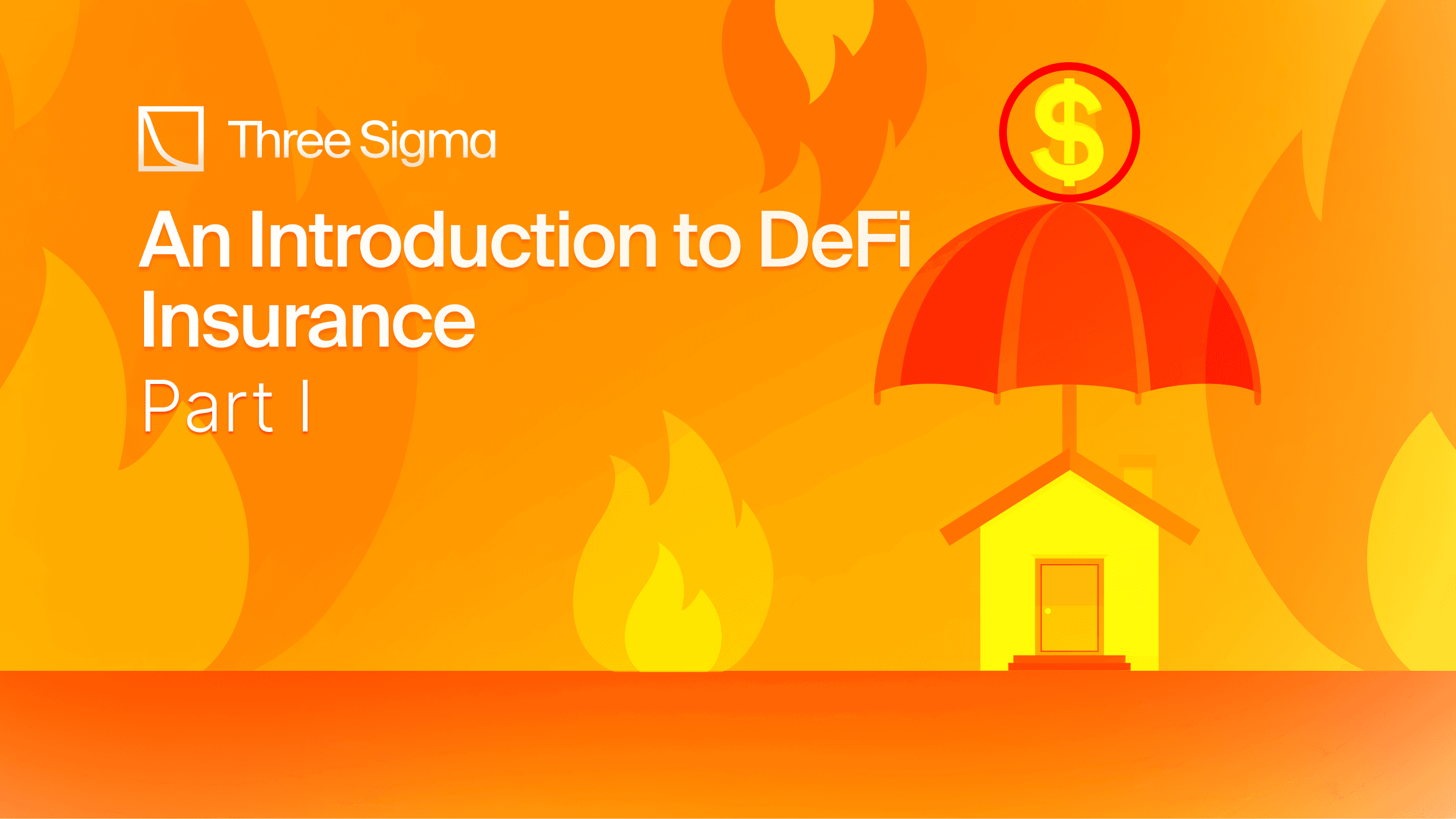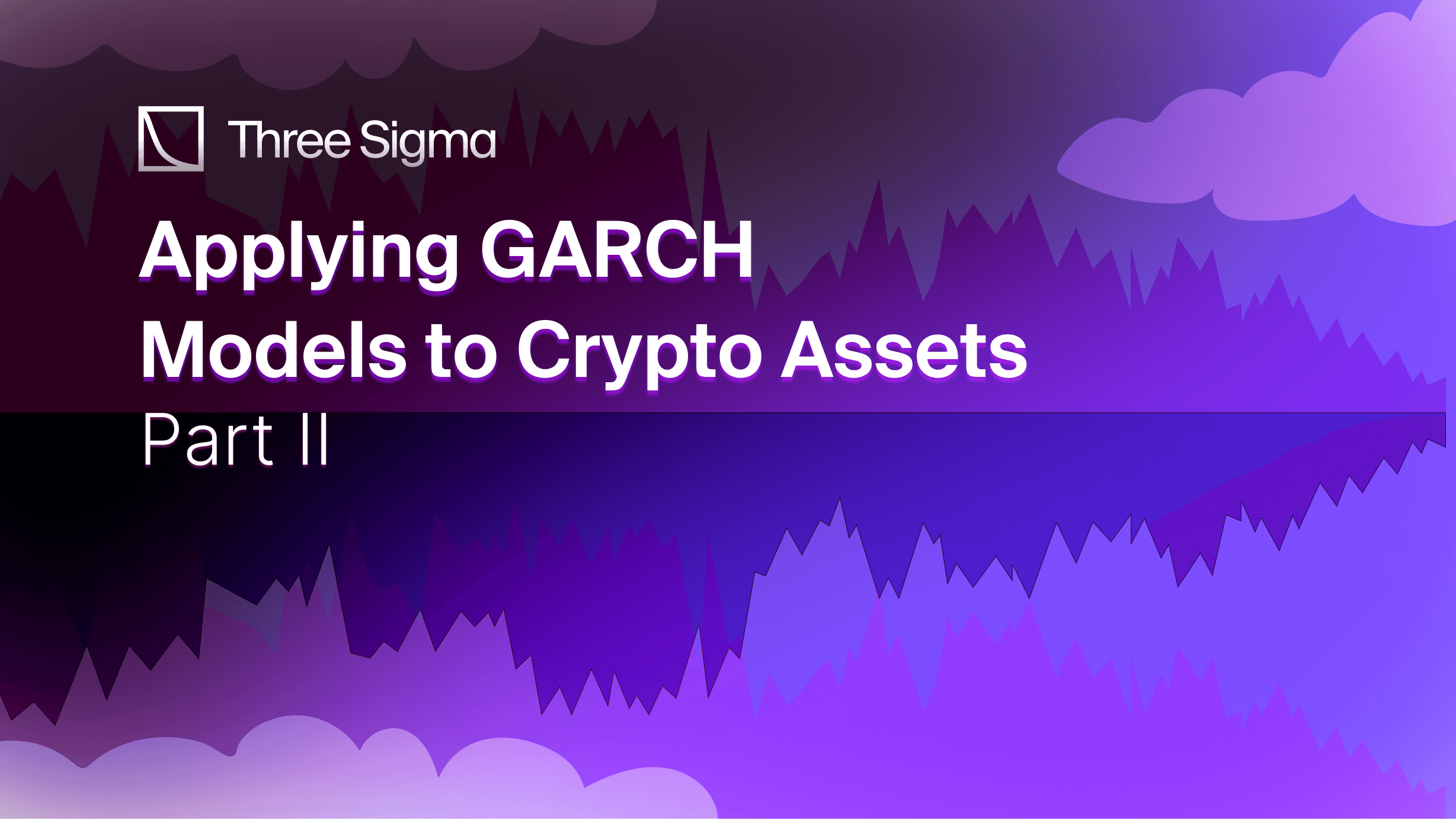Introduction Volatility Modeling of Cryptocurrency
The crypto market has been subject to significant turbulence, as evidenced by events like the market crash in May 2021, which caused its market cap to drop by more than 40% in a matter of days. These sudden price swings, along with other recent news stories like the Silicon Valley Bank's collapse, have been repeatedly emphasising the need for better risk management in the industry. We at Three Sigma, along with other researchers and developers, have been looking at cutting-edge techniques to build more reliable risk models that can better handle these complexities and solve this important problem.
Volatility is a crucial factor that must be considered since it significantly affects all risk models. While it has been extensively researched in the context of traditional finance, the emergence of crypto markets has introduced new challenges that require a deeper analysis of this subject. Crypto assets are characterized by unique features such as large sudden price swings and lack of regulation, which can introduce new risks and uncertainties that cause the need for a revision of the techniques used to account for volatility. In this article, we aim to provide a comprehensive evaluation of the volatility dynamics in the cryptocurrency market by exploring how volatility can be successfully modeled. This blog article is the first of two, and here we examine volatility as a statistical metric, its peculiarities in the cryptocurrency market, and the models, including the GARCH model of volatility, that have been used to try to explain it.
What is volatility and why should we model it?
Volatility is a statistical measure of the dispersion of data around its mean over a period of time. In finance, it typically refers to the extent of fluctuation in an asset's price over time.
In the financial system, volatility is important because it affects the price of assets such as stocks, bonds, and currencies. When there is high volatility in the market, it can lead to significant fluctuations in the prices of these assets, which can create opportunities for profit or pose risks for investors. It can also affect the stability of the financial system as a whole, as large swings in asset prices can lead to systemic risks.
In the crypto industry, considering volatility is even more significant, as most cryptocurrencies are highly volatile due to their relatively small market sizes, lack of regulation, and speculative nature. For example, those who bought Bitcoin in early 2017 saw its price rise from around $1,000 to nearly $20,000 by the end of the year, while those who bought at that peak saw its price drop to around $3,000 in 2018. As can be seen in the chart below, these were not even the most significant price movements, which came after 2020.

Volatility is a crucial factor in risk management, pricing, and portfolio construction for both the traditional financial system and the crypto industry. Portfolio managers use it to assess overall portfolio risk, and algorithms use it to determine appropriate trading rates in real-time.
Volatility is also used to price options and other structured products, and traders use it to understand potential price movements over the trading day and compute trading costs. In option pricing theory, volatility is used to measure the risk of a security, with higher volatile assets bearing more risk associated with a greater probability of higher returns. The balance between risk and return is known as the risk-return trade-off, which investors must consider when making investment decisions. In addition, volatility itself might be traded speculatively through derivatives.
Volatility Properties
Volatility, while not directly observable, is manifested in many asset returns and traditionally exhibits some characteristics. These characteristics, known as stylized facts, include volatility clusters, in which periods of high and low volatility alternate, and fat tails in its probability distribution, indicating a greater likelihood of big fluctuations than what would be expected in a normal distribution.
Moreover, volatility fluctuates arbitrarily and repeatedly, with volatility spikes persisting before settling to a long-term level. It also typically exhibits mean reversion, as it remains within a set range. In addition, the so-called leverage effect typically causes an asymmetric effect in which a large price decline has a greater impact than a significant price increase, resulting in larger spikes of negative than positive volatility. This will be further elaborated later on in the text. Heteroskedasticity, which refers to situations where the variance of residuals is not constant across a range of measured values, is also usually observed.
Similar properties were also detected in the returns of crypto assets. However, empirical studies have indicated that the cryptocurrency market exhibits greater volatility and that its probability distribution presents fatter tails than in traditional financial markets (Tsyvinski & Liu, 2018; Alexander & Gholampour, 2018; O'Connor, 2019).
The chart below shows the logarithmic returns of Bitcoin since its inception, demonstrating the phenomena of volatility clustering and mean reversion. This pattern may be observed for example in the Bitcoin returns chart around 2018, when a period of high volatility was followed by a period of lower volatility.

The images below show quantile-quantile (Q-Q) plots for the S&P 500 and Ether logarithmic returns. This type of plot is a graphical tool that enables us to determine if a data set is likely to have originated from a theoretical distribution like the normal distribution. It is recommended to use a normal Q-Q plot to verify the assumption that the residuals are normally distributed if we do a statistical analysis on that assumption.
When two sets of quantiles are plotted against one another, the result is a scatterplot known as a Q-Q plot. The points should form a relatively straight line if both sets of quantiles originated from the same distribution. Nonetheless, when contrasted to a normal distribution, the patterns seen in the charts below are indicative of a distribution with heavy tails. In other words, the distribution deviates further from a normal distribution's predicted level of variance. Disregarding outliers, it is also interesting to note that although the S&P 500 distribution bends upward for a few observations in the right tail, Ether returns exhibit a smooth curve upward. This might be a sign of a left skew in the S&P 500 returns, or an asymmetric distribution, as shown by a larger tail to the left.
The aforementioned leverage effect, which refers to the well-established negative relationship between return and future volatility might be responsible for this. It states that volatility rises after large price declines, whereas for upward price movements this effect is smaller. This is typically observed in the stock market, but it has been found to not be as strong in crypto assets (Zhao, Chen, & Zhang, 2022). It is indeed noticeable that the S&P500 returns seem to exhibit this impact more so than the Ether.
The cryptocurrency market is less regulated and lacks fundamental drivers, resulting in greater randomness and unpredictability in price fluctuations. Moreover, the asymmetry effect may be less widespread in the cryptocurrency market due to the presence of more enthusiastic and less sophisticated traders who take a price increase as a positive trend. Understanding these unique characteristics of the cryptocurrency market is critical for the accurate analysis and forecasting of its financial time series.


Volatility Models
These stylized facts have provided the foundation for the development of various volatility models. Volatility models can be categorized into two primary types: implied or forward-looking volatility models and conditional or historical volatility models. Implied volatility models aim to capture how the market perceives volatility, often with a premium.
The methodology to obtain estimates through these models include reverse engineering of option pricing and other structured products. Some use cases include the VIX, which is the most commonly used index for volatility in the S&P 500, and the VI, which is a similar index for crypto assets. In contrast, conditional or historical volatility models utilize past data to estimate volatility. Examples of these models are quadratic returns, standard deviation, beta, the Heston model, and the ARCH/GARCH models. By using past data or market perception, these models provide insight into the volatility of a given asset or market, which can help investors make informed decisions.
The introduction of the ARCH model by Engle in 1982 led to the widespread use of the ARCH family models for volatility modeling and forecasting of economic and financial time series. Over the years, the family has expanded to include a large number of models, with the GARCH(1, 1) model proposed by Bollerslev and Taylor in 1986 becoming one of the most popular ones. To gain a deeper understanding of the various models within the ARCH family, Hansen and Lunde (2005) conducted a comprehensive review and comparison. During the years, numerous extensions of the GARCH model have arisen in an attempt to address some of the drawbacks of the basic GARCH model, such as its inability to reflect the asymmetry between the impact of positive and negative shocks on volatility.
The IGARCH model permits the incorporation of long-term dependencies in volatility, whereas the EGARCH model accounts for the leverage impact. The ARGARCH model includes autoregressive elements to account for the persistence of volatility shocks. These modifications have tried to enhance the precision and dependability of financial time series research and forecasting.
The present research is focused on conditional volatility models of the GARCH/E-GARCH variety due to their ability to address a wide range of volatility features. Firstly, these models incorporate lagged volatility terms in their equations, which effectively accounts for the persistence feature commonly observed in financial markets returns. Additionally, GARCH and EGARCH models account for volatility clustering by considering both past returns and past volatility.
The basic GARCH model ignores the impact of the signs of residuals on volatility, since it only considers squared residuals. However, as mentioned before, negative shocks tend to affect financial volatility more than positive shocks. To account for this, Nelson (1991) introduced the EGARCH model, which incorporates this effect. By taking into account these various volatility characteristics, GARCH/E-GARCH models have proven to be useful tools for estimating volatility in financial markets.
Given the established usefulness of GARCH/E-GARCH models in estimating volatility in financial markets, as demonstrated by well-known resources such as Zivot and Wang (2006) and Gonçalves and Meddahi (2018), this study aims to explore the applicability of these models in the context of cryptocurrency markets.
The GARCH Class
Following George Box and Gwilym Jenkins’ 1970 publication "Time Series Analysis: Forecasting and Control," in which they presented the ARMA (autoregressive moving average) model and its variations as effective approaches for modeling and forecasting time series data, the ARMA model and its variants have been widely adopted. Since then, the ARMA model has become not only a widespread statistical tool for time series analysis, but also a common technique in applied fields, such as finance, economics, engineering, and environmental research. The ARMA model combines two processes: the autoregressive (AR) process, which models the relationship between an observation and its previous observations, and the moving average (MA) process, which models the relationship between an observation and its past errors. The ARMA model is commonly denoted as ARMA(p, q), where p and q represent the orders of the autoregressive and moving average components, respectively. It is formally described as follows:
where:
is the time series value at time t;
is the constant term or intercept;
are the autoregressive coefficients;
are the moving average coefficients.
represents a random innovation, i.e random noise for which:
;
, where is the variance of the innovation.
The AR(p) process is a type of autoregressive model, where the value of the current observation is modeled as a linear combination of its p previous values (Cryer and Chan, 2008, p. 66). The parameter p represents the order of the autoregressive model, indicating the number of previous time lags included in the model. The AR(p) process is useful for identifying trends, seasonal patterns, and other patterns in time series data, and it can be used to make predictions about future values of the series. It is described by the following equation:
Similarly, the MA(q) process is a type of time series model where the value of the current observation is modeled as a linear combination of q previous errors (Cryer and Chan, 2008, p. 57-65). The MA(q) process is used to remove the effects of random fluctuations or noise in the time series data, and it is particularly useful for identifying short-term patterns in the data. By analyzing the residuals of an MA(q) model, it is possible to identify any systematic patterns or trends in the data that may be useful for forecasting future values of the series. It is described by the following equation:
The above-mentioned models entail that the variance of innovations, also known as volatility, remains constant throughout time; this is referred to as homoscedastic variance. Nevertheless, this assumption is often too restrictive for real-world data, as it does not account for modeling of characteristics such as volatility clustering. To address this issue, Engle (1982) proposed the ARCH (Autoregressive Conditional Heteroskedasticity) model, which takes into consideration the heteroscedastic variance of a time series applied to an AR(p)-process. Later, Bollerslev (1986) introduced the GARCH (Generalized Autoregressive Conditional Heteroscedasticity) model, a generalization of the ARCH model.
The ARCH model is a type of time-series equation that extends the ARMA model by adding an extra component to capture the series' conditional variance. Specifically, the ARCH model estimates the conditional variance of the series using only the autoregressive (AR) component of the ARMA model. The ARCH model assumes that the conditional variance of the series at time t is a function of the AR model's past squared errors, or residuals.
Since Engle's original paper, the ARCH model has been frequently utilized in finance and economics to represent time-varying financial data volatility. Several extensions have been applied to the model, including the GARCH model. The GARCH model allows for time-varying volatility in the series, similar to the ARCH model, but it extends the ARCH model by capturing the persistence in volatility. Bollerslev's GARCH model models the conditional variance of a time series using both the autoregressive (AR) and moving average (MA) components of the ARMA model.
The Generalized Autoregressive Conditional Heteroskedasticity (GARCH) model can be derived by combining the ARMA (p,q) process defined above and by using the conditional variance .
assuming , where are standardized residuals.
A volatility-GARCH(p,q) process is defined as
where:
is the conditional variance at time t;
is the constant term or intercept;
are the autoregressive coefficients;
are the moving average coefficients.
The residuals are generally assumed to follow a normal distribution. This is an important assumption, as it allows the use of standard statistical techniques, such as maximum likelihood estimation, to estimate the model's parameters. It is important to point out, however, that the assumption of normality may not hold in practice. In certain cases, alternative distributions, such as the Student's t-distribution or the Generalized Error Distribution (GED), may be preferred, as discussed in the second part of this article. These distributions are more flexible and can accommodate heavy tails or skewness in the residuals distribution.
GARCH (1,1)
The most commonly used GARCH model is the GARCH(1,1) model, which specifies that the conditional variance at time t is a function of the squared error term at time t-1, the conditional variance at time t-1, and a constant term. As described in the equation below, the GARCH(1,1) model has three parameters, which are estimated from the data using statistical techniques such as maximum likelihood estimation. Many studies find that the simple GARCH(1, 1) model provides a good approximation to the observed temporal dependencies in daily data; see Baillie and Bollerslev (1989), Bollerslev (1987), Engle and Bollerslev (1986), and Hsieh (1989) for some of the early evidence.
assuming , where are standardized residuals.
where:
is the conditional variance at time t;
is the constant term or intercept;
is the autoregressive coefficient;
is the moving average coefficient.
EGARCH
The EGARCH (Exponential GARCH) model is an extension of the GARCH model, which allows for asymmetric effects of positive and negative shocks on volatility. While both models incorporate the ARMA components to model the conditional variance of a time series, the EGARCH model allows for non-linear effects of the ARMA components. This non-linearity allows the EGARCH model to capture more complex patterns in the conditional variance, including asymmetry in the response of volatility to positive and negative shocks.
Furthermore, unlike the GARCH model, the EGARCH model imposes the restriction that the sum of the coefficients of the AR and MA terms must be less than one in order to ensure the model's stationarity. This restriction can be seen as a disadvantage of the EGARCH model as it limits the flexibility of the model, but it also ensures that the model is well-behaved and can be easily estimated. This model is described by the following equation:
assuming , where are standardized residuals.
where:
is the conditional variance at time t;
is the constant term or intercept;
are the autoregressive coefficients;
are the moving average coefficients;
are the leverage effect coefficients;
is the expected value of
The GARCH universe has evolved over time from the ARMA model to the ARCH and GARCH models, each of which are more complex. These models allow modeling of time-varying volatility and volatility persistence in financial data. As the financial markets continue to evolve, so do the GARCH models, with newer extensions such as EGARCH, TGARCH, and IGARCH being developed to capture different volatility features.
You can also check how GARCH models are applied in cryptocurrency markets.
Whether you’re pricing risk or designing dynamic incentives, volatility isn’t noise, it’s the signal. Our DeFi Ecosystem Strategic RD service helps translate market behavior into models your protocol can trust under pressure.
Conclusion
Volatility is a crucial factor in risk management, pricing, and portfolio construction in both traditional financial systems and the cryptocurrency industry. However, the unique features of the crypto market highlight the importance of studying a tailored approach to modeling and forecasting volatility in that context. To achieve this, this study focuses on the GARCH/E-GARCH models, which can account for various volatility features such as persistence, clustering and asymmetry. The GARCH family of models has proven to be a valuable tool for estimating volatility in financial markets, and this article examines its applicability to the cryptocurrency market.
In the next part of this article, we will provide a comprehensive assessment of the cryptocurrency market's volatility dynamics. This is achieved by estimating models that better account for volatility using various specifications, parameters, and lags. We will describe our methodology, discuss the results, provide recommendations, and outline future research directions.
Sources & References
- Alexander, C., & Gholampour, V. (2018). Bitcoin: Medium of exchange or speculative assets? Journal of Financial Economics, 130(2), 367-378. https://doi.org/10.1016/j.jfineco.2018.05.005
- Box, G. E. P., & Jenkins, G. M. (1970). Time series analysis: Forecasting and control. Holden-Day.
- Chan, J. C. C., & Eisenstat, E. (2020). Time-varying price discovery in cryptocurrency markets. Journal of Empirical Finance, 56, 42-58.
- Gherghina, Ş.C. & Simionescu, L.N. (2023). Exploring the asymmetric effect of COVID-19 pandemic news on the cryptocurrency market: Evidence from nonlinear autoregressive distributed lag approach and frequency domain causality. Financial Innovation 9, 21. https://doi.org/10.1186/s40854-022-00430-w
- Gonçalves, S., & Meddahi, N. (2018). Multivariate GARCH models: A survey. Journal of Applied Econometrics, 33(1), 1-23. https://doi.org/10.1002/jae.2574
- Hansen, P. R., & Lunde, A. (2005). A forecast comparison of volatility models: Does anything beat a GARCH(1,1)? Journal of Applied Econometrics, 20(7), 873-889. https://doi.org/10.1002/jae.837
- Liew, V. K. S., & Baharumshah, A. Z. (2018). On the returns of Bitcoin investment. Economics Letters, 166, 23-27.
- O'Connor, M. (2019). The efficiency of the Bitcoin market: An analysis of Bitcoin market efficiency and volatility using Google search data. Journal of Risk and Financial Management, 12(3), 114. https://doi.org/10.3390/jrfm12030114
- Selmi, R., & Mensi, W. (2017). The impacts of terrorism on stock market volatility: Evidence from eight OECD countries. Finance Research Letters, 21, 36-42.
- Tsyvinski, A., & Liu, Y. (2018). Cryptocurrencies as an asset class: An empirical assessment. National Bureau of Economic Research. https://doi.org/10.3386/w24877
- Zivot, E., & Wang, J. (2006). Modelling financial time series with S-PLUS. Springer Science & Business Media. https://doi.org/10.1007/0-387-28663-0
- Zhao, X., Chen, W., & Zhang, Y. (2022). The impact of economic policy uncertainty on cross-border mergers and acquisitions: Evidence from China. Journal of Finance and Economics, 11(1), 1-20. https://doi.org/10.1186/s40854-022-00430-w

Economic Modeler
Carolina is a data analyst with a Master’s degree in analysis and engineering of big data and a background in mathematics applied to economics and management. She has experience working on optimization problems, leveraging statistics to produce simulations and extract valuable insights. She joined Three Sigma with a continued passion for finding knowledge in data and an interest in improving the blockchain industry by contributing to its sustainable development. Outside of work, Carolina enjoys traveling and immersing herself in foreign environments.

Economic Modeler
Joana has a Master’s degree in finance and a background in mathematics applied to economics and management. She has spent the past three years working at a private equity company, becoming familiar with traditional finance concepts and honing her analytical skills. The opportunity to blend her mathematical expertise with her finance background is what initially sparked her interest in the blockchain field. Joana joined Three Sigma with a strong eagerness to make a valuable contribution to the world of decentralized finance, which she excitedly believes has great potential. In her free time, Joana enjoys traveling and engaging in sports.






